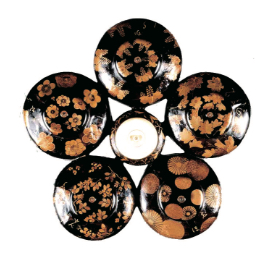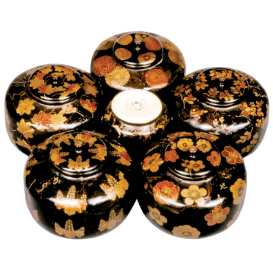A bit of knowledge about lacquer
Lacquer is the material used in the lacquerware craft that has developed in Japan, China, the Korean peninsula and Southeast Asia. That history in Japan is ancient, dating all the way back to the end of the Jomon period, with numerous pieces of lacquerware unearthed in archeological digs. With the influx of Buddhism from the mainland, lacquerwares also flowed into Japan, which was the stimulus for a marked development in the level of craftsmanship, with even foreign countries praising that craftsmanship. So much so, that Japanese lacquerware was sometimes esteemingly referred to as “Japan”.

Lacquer tapping
The lacquer tree is a deciduous tall tree that grows in Southeast Asia, China, Korea and Japan, etc. Horizontal cuts are made in the trunks to tap the lacquer sap.
Lacquer is incredibly precious, it takes ten years of tapping to fill a single tea bowl with lacquer sap. Impurities are strained out, and the cleaned lacquer is heated and stirred to refine it.
At present, lacquer produced in Japan is on the decline, with it making up just a mere three percent of commercial lacquer – an extremely rare material!

Lacquer as a base material
Lacquer is used to coat many materials. It works well with wood. And, in Japan, when used as the base material to coat wood, it is called “mokutai”. Other names include “tai” (long, thin strips of tree or bamboo are built up in multiple layers to create a receptacle that is then lacquered), the famed “ikkan-bari” (lacquered papier-mache ware), “rantai” (lacquering of woven bamboo items) and “kintai” (metallic lacquerware). Then there is “kanshitsu”, where a shape is formed out of hemp cloth, and lacquer repeatedly applied to the hemp, finally the dried lacquer form is removed from the hemp mold. This method was used in ancient times to make Buddhist statues.
Features of Kyoto lacquerware
Among all the lacquerware areas of Japan, Kyoto lacquerware is noted for thinness of the wood material that lacquer is applied to. Some places apply elaborate undercoats that have gold or silver lacquer applied to them in beautiful, intricate motifs. The undercoat is provided by a fine polishing powder made from weathered slate and shale. This powder was a specialized product made in the Yamashina area of Kyoto.
Decorating the surfaces of lacquerwares with gold or silver powder is a technique that dates back to the Nara period, and has been a Kyoto craft for 1200 years since the Heian period. With the emergence of the tea ceremony in Japan, and the inner beauty of wabi-sabi coming to the fore, lacquerwares became even more popular.
Preeminent examples of such beautiful artworks can be found in Kodaiji Temple, founded by the warlord Hideyoshi and his wife Nene. The works in question are known as Kodaiji Makie, falling into the bracket of Momoyama art. The gold motifs on these lacquerwares were created by delicately sprinkling gold powder onto a black lacquer base and then using tools, such as a needle, to delineate the gold into motifs. So informal and innovative were the designs, that warriors of yore were besotted by them.
And the beauty of gold lacquerware has continued to steal hearts for a thousand years to this very day.
Photo: Kodaiji makie (Kodaiji Sho Museum )